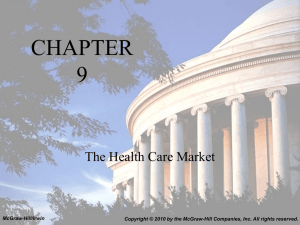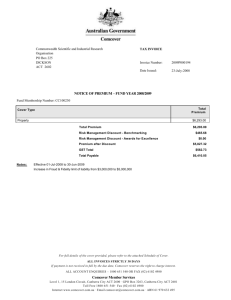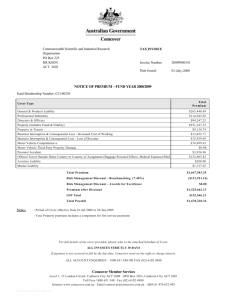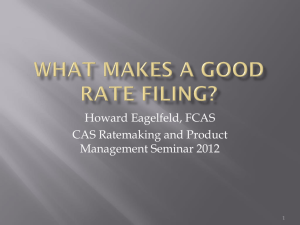file
advertisement
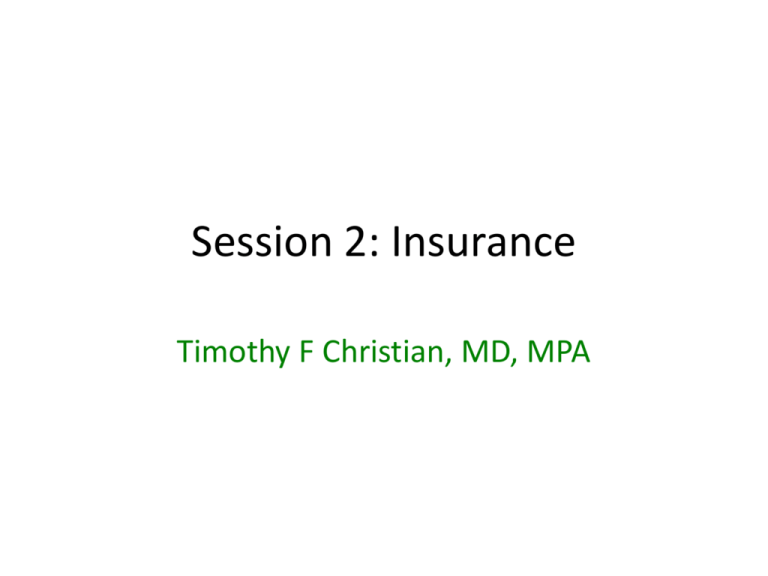
Session 2: Insurance Timothy F Christian, MD, MPA Insurance: Pooling Eq. • Components of Insurance pricing: • 1. Actuarial fair premium price • 2. + degree of risk aversion present in population • Total cost of premium is a pooling equilibrium of these 2 forces resulting in unequal fairness in policy price for some. Pooling eq. 2 • Actuarial fair price calculation: • Risk of MI= 1% in group, Cost of MI care=$30,000 • Fair actuarial price of premium = $30,000 x 0.01= $300 • but price may be higher if population is wealthy and risk adverse. • For eg. the willingness to pay (WTP) for risk avoidance may be $100 (peace of mind). • WTP Premium = $400 Law of Large Numbers • • • • Cost = Prob event (P) x cost event (L) With insurance, Premium = P/N x L N= number of people in pool, bigger is better Eg: (N=100) Prem = 0.01/100 x $100,000 = $10 • Eg2: (N=50,000) Prem = .01/50,000 x 100,000 = .02 (2 cents): a 500-fold reduction in cost! • Implications for LDCs, National Plans Distortions in the Insurance Market Adverse Selection • Adverse selection: Information is asymmetric; the individual knows their risk whereas as the insurer does not (and cannot by law often). • Consequently sick and healthy clients look the same to insureres but sick pts are more likely to buy insurance • they know they will need it in the short-term so those that buy insurance are an adverse population that will file claims Adverse Selection Example • Group H (n=100) risk of event 0.5%/yr • Group U (n=100) risk of event 5%/yr • Anticipated claims=(H100x0.005x$30,000) + (U100x0.05x$30,000)= $165,000 For the system to work fairly, the insurance company will charge the low risk group $30,000 X 0.005= $150 and the high risk group $30,000 X 0.05= $1500 • But, The Insurance companies cannot Identify who is H and who is U • =Community Rating and guaranteed Issue AS: Race to the Bottom • To Keep all in pool, insurance charges all pts $150 (30,000x0.005)=$150,000 • Actual claims will be $165,000=$15,000 shortfall: company fails • In order to recoup $165,000 Ins Co. assigns a higher premium to all participants: $165,000/200= $825. Now high risk are paying $675 less than actual cost of $1500 and low risk are paying $675 more than fair cost of $150 • No incentive for Healthy to stay in the pool (separating eq) unless MANDATED-see Obamacare Race to the Bottom 2 • • • • !00 healthy pts leave pool Total payout = 100 X .05 X $30,000= $150,000 Total take in from premium =100 X $825= $82,500 $82,500-$150,000= -$67,500. Company fails unless premiums raised. • New premium=150,000/100=$1500 • Another group of more risk tolerant pts leave pool • Cycle repeats with ever higher residual risk pool Moral Hazard • Moral Hazard: Occurs once insurance is in place (regardless of mechanism) – Events tend to increase because policy holders take risks they might not otherwise take if uninsured (minor) – Consumption of health care increases by policy holder as more likely to utilize health care system (major issue) – Providers generate waste by providing or prescribing more health care for those with insurance (major) • All of the above shown to always increase health care spending when insurance coverage is expanded. • Outweighs preventative strategies (ER Utilization) Insurance Failure in LDCs Why the LDCs pay the highest out-of pocket for HC 1. Affordability argument: Countries are too poor to provide national insurance programs 2. Political choice: spending funneled into favored programs or lost to corruption 3. Inferior tax instruments: no precedent in tax revenue, revenue raising mechanisms, and economies too frail to survive the dead weight loss of any tax. RAND Health Insurance Experiment Copayment level will be critical in Vermont with universal coverage The ER Myth • Covering the uninsured will reduce costs as care will switch from ER to prevention • Reality: that costs go up as coverage increases secondary to moral hazard. Why is Health Care Market Failure? 1. 2. 3. 4. 5. Prices for services are fixed by insurers/Gov Assymetric information consumer/producer Inelastic demand element for health-care Subsidies by Government Consumer price shielding thru insurance & deficit spending 6. Pharmaceutical and device monopolies/IPR 7. Social insurance=redistribution of wealth The Inefficiency Inherent in anyTaxation S Price P+T 1 DWL P* 2 At P* and Q* the area 1 + 2 is maximized D Q* Quantity ITF 110 Types of insurance • • • • • Private monopoly Private competition model HMO type: Minn. Private annual policy: India Social Insurance – Single Payer National: Medicare, Vermont – Multi-payer National: Israel – Private-payer Mandate: ACA, Mass. Social Insurance • A non-voluntary transfer of wealth using pooling equilibrium. • Mandatory participation, universal coverage • Requires strong government – Gov. as enforcer of penalties for noncompliance – Legal framework and infrastructure to carry out – Economy of scale – Paternalistic approach Single Insurance Payer Advantages Disadvantages • Broad coverage potential • Cost Containment via centralized board • in Administrative costs • Ease for Providers • Monitor for abuse • Standardize metrics for quality • Can be a tax vs mandate • • • • • Lack of competition, choice Eliminates jobs Concentration of authority incentive for innovation Business: fewer options to recruit employees • Conflicts with Federal Programs and statutes • Social insurance
